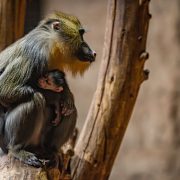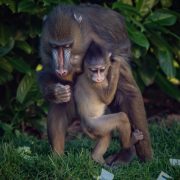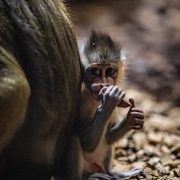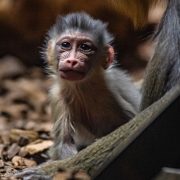Mandrills are the world’s largest monkeys and are vulnerable to extinction in the wild.
We are excited to announce the arrival of two baby mandrills at the zoo!
The precious primates entered the world just five weeks apart and are the first of their kind to be born at the zoo in more than a decade.
The first to arrive was born to 10-year-old mum Brio, providing her with her first taste of parenthood, with the second infant arriving to more experienced mum, Obi (17). The new babies are half siblings and share the same dad, Kamau (11).
Mandrills are listed as vulnerable on the International Union for the Conservation of Nature’s (IUCN) Red List of threatened species, with numbers in the wild having declined significantly in recent years.
You know what they say about buses! To have two baby mandrills, born within weeks of each other, after more than 10 years, is just incredible. The two new arrivals will only spend a few months at their mums’ sides before gaining enough confidence to explore on their own with the rest of the group.
Siobhan Ward, Primate Keeper
Siobhan continued to say:
“Mum Brio was actually the last baby to be born at the zoo more than a decade ago and, as a first-time mum, she’s doing a wonderful job and has adapted to parenthood brilliantly. Both mums, Brio and Obi, will have the rest of the mandrill horde to help care for their new babies, as it’s a real group effort, but once they branch off and start to explore they’ll certainly be kept busy.”
We’re caring for vital insurance populations of mandrills, as part of our key role in tackling the global biodiversity crisis.
Dr. Nick Davis, Assistant Curator of Mammals at the zoo, added:
“Like many primate species, mandrills live in large and very complex groups made up of strict hierarchies. Our primate experts, using their decades of experience and know how, have closely monitored the group over the years to understand its delicate balance.
Now, Kamau, a new dominant male who has been carefully integrated with the other 10 members, appears to have really hit it off with the females. The two youngsters he has sired will now join a co-ordinated breeding programme with other leading conservation zoos and add to the important insurance population for this charismatic species.”
Mandrills are the world’s largest monkey species and are native to a region of Western Africa. They are born with grey faces, but will soon start to develop their iconic red muzzle, with blue ridges on both side of their faces, as they mature and reach adulthood.
This spring, we’ll be shining the spotlight on unusual and lesser known species like mandrills.
OUR TEAM OF EXPERTS WORK IN SIX REGIONS AROUND THE GLOBE – REPRESENTING SOME OF THE PLANET’S MOST BIODIVERSE HABITATS. Discover more about our SCIENCE AND CONSERVATION work.
NOW is the time to ACT FOR WILDLIFE. Conservation is CRITICAL; species are under threat. TOGETHER we can make a BIG difference. Take action TODAY and join us in PREVENTING EXTINCTION.



